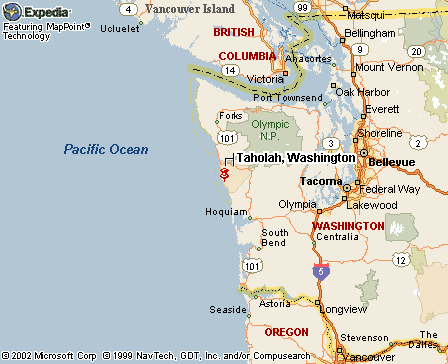|
|
Canku Ota |
|
|
(Many Paths) |
||
|
An Online Newsletter Celebrating Native America |
||
|
August 10, 2002 - Issue 67 |
||
|
|
||
|
For Quinault Indian Women, Weaving Really is a Labor of Love |
||
|
by Lisa Patterson Daily
World Writer
|
||
|
credits: photo of
woman stripping cedar bark Copyright © 1995 by The Royal British
Columbia Museum.
|
 TAHOLAH
- When Quinault Indian Nation women weave cedar bark, sweet grass or other
gifts borrowed from nature, their creations take on a life of their own. TAHOLAH
- When Quinault Indian Nation women weave cedar bark, sweet grass or other
gifts borrowed from nature, their creations take on a life of their own.
"You have to have good thoughts when you weave, because those thoughts will go into what you make," said Alaina Capoeman, of the Quinault Indian Nation. "I try to think about who I'm making it for." Perhaps that's why for centuries tribal women gathered, prepared and weaved materials in a group. Not only was it a learning experience, but it created an ageless ambiance - a special social time where goodness could flow from fingertips into the crafts at hand. "If you are having bad feelings when you're weaving, you need to stop or you'll weave those in." added Michelle Aguilar - Wells. Last week, six women gathered at a home in Taholah to manipulate thick ribbons of old - growth cedar bark into works of art. They made belts, headbands, decorative rose buds, vests and more. Most of what they made will be given away to other tribal members as gifts during the "Paddle to Quinault 2002." About 40 canoes from tribes in Washington, Alaska and Canada are traveling down the coast now. A three - day celebration and potlatch will be hosted in Taholah Aug. 10 to Aug. 12. In all, the journey will take tribal members about 95 miles down the Pacific Ocean from the tip of the Olympic Peninsula to the mouth of the Quinault River. Some tribes started their journey more than a week ago on the Kitsap Peninsula and had already traveled about 106 miles in the Puget Sound to Neah Bay. 'A labor of love' The bark the women were weaving was stripped from an ancient tree deep into the forest last year. It was kept cool and dry until they were ready to use it. To make it pliable, they soaked the bark strips in a steel bath tub full of water overnight. Turning cedar into beautiful and functional items is a labor of love - literally. It's "amazing" to think that sturdy cedar trees used to make homes, furniture and canoes can also be used to make baskets, hats and clothes, said Leilani Asumooth Chubby, a master basket weaver. But before they take anything from nature, they say a prayer and sometimes offer a gift, such as some tobacco. "When you pull the bark from the tree, you have to put muscle into it," Chubby said. She is also the manager at the Quinault Cultural Center & Museum in Taholah where several baskets and other woven items made by Native Americans are on display. The women used a sturdy leather cutting tool made of metal to trim thick bark into smaller strips. One woman would pull the bark through the sharp cutting tool while another woman would hold onto the opposite end, trying to keep the wet, slippery bark straight for even paring. It's a tedious task, although quicker than doing it the old fashioned way - using a knife or a homemade cutter, trimming bark one strip at a time. Any sticky pitch needs to picked off the bark before it can be used. "It's hard to weave alone," said Capoeman. "It's such a social thing." Miss Quinault 2002, Chelsea Capoeman, 16, showed off her beautiful crown made of woven cedar and grasses. "It's traditional," she said. "I'd rather have this than some big fancy - schmancy thing." Capoeman twisted small strips of cedar to form rose buds to put in her long, dark braided hair and on her sash. She'll pluck them off to give to other tribal members along the canoe journey, where she will paddle the entire way. Chubby is proud to say that most all the young women in Taholah know how to weave cedar. All have their own, distinct style. Chubby remembers a time when young people were losing interest in learning such skills and is pleased that culture and tradition are still alive and well on the reservation. "It heals you," Chubby said. "When you're stressed you can stop and sit there - let it be all you do." Aguilar - Wells said that weaving makes her feel whole. "It makes you feel good and strong - connected to who you are," she said. "It's about creation and recreation. "It's a propagation of our culture."
|
||||
|
|
||
|
|
||
| Canku Ota is a free Newsletter celebrating Native America, its traditions and accomplishments . We do not provide subscriber or visitor names to anyone. Some articles presented in Canku Ota may contain copyright material. We have received appropriate permissions for republishing any articles. Material appearing here is distributed without profit or monetary gain to those who have expressed an interest. This is in accordance with Title 17 U.S.C. section 107. | ||
|
Canku Ota is a copyright © 2000, 2001, 2002 of Vicki Lockard and Paul Barry. |
||
 |
 |
|
|
The "Canku Ota - A Newsletter Celebrating Native America" web site and its design is the |
||
|
Copyright © 1999, 2000, 2001, 2002 of Paul C. Barry. |
||
|
All Rights Reserved. |
||
